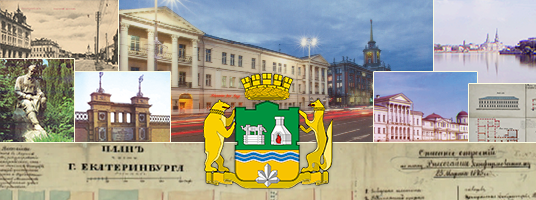City of Yekaterinburg

The collection marks the 300th anniversary of the city of Yekaterinburg, which is celebrated in 2023. The history of the city to the present day is based on official documents, archival materials, statistical data, reference books and guidebooks, research, visual and cartographic sources as well as audio recordings.
By decree of Peter the Great, the largest ironworks was founded in the Middle Urals. The birthday of the fortress city of Yekaterinburg is November 7 (18), 1723, when the factory workshops were launched. The location for the future city along the banks of the Iset River was determined by the artillery engineer and historian V. Tatishchev, his proposal was supported by the head of the administration of the mining plants V. Gennin. The name of the city was given in honor of the emperor’s wife, Catherine I. Yekaterinburg was built as the capital of the mining region; in its technical equipment, its plant in the first years of operation surpassed metallurgical enterprises not only in Russia, but also in the world.
In 1781, Catherine II granted Yekaterinburg the status of a district city of the Perm province, and the country’s main road, the Great Siberian Highway, was built through its territory. Yekaterinburg, among other Perm cities, has become the key city to endless Siberia, the “window to Asia”. Emperor Alexander I gave the city the status of the only “mountain city,” and the discovery of a placer gold deposit nearby in 1814 predetermined Yekaterinburg’s “Golden Age” as the period from the 1830s to the 1850s is called. The city was governed by the Yekaterinburg mining chief, the minister of finance and the sovereign personally; the provincial authorities had no influence. Under Emperor Alexander II, the situation changed, and Yekaterinburg was returned to its former district status.
At the turn of the 19th and 20th centuries, the city became one of the centers of the revolutionary movement in the Urals. Soviet power was established here the day after the Bolsheviks came to power. In July 1918, in the basement of the house of engineer Ipatiev, the last emperor of the House of Romanov, Nicholas II, was shot with his family and several servants. During this period, Yekaterinburg was the center of the Yekaterinburg province, in 1923–1934 - the Ural region. On October 14, 1924, the City Council decided to rename the city in honor of the Bolshevik Ya. Sverdlov. In the 1930s, the construction of giant machine-building and metallurgical plants began here, which transformed industrial Sverdlovsk.
The city made a huge contribution to the victory in the Great Patriotic War: the 22nd and 70th armies, several divisions, including the Ural Volunteer Tank Corps, were formed here; in total, more than 100 thousand residents went to the front. Sverdlovsk became the largest evacuation point; more than fifty large and medium-sized enterprises from the western regions of Russia and Ukraine were transferred here. In the post-war years, mass housing construction began, and in 1980, the construction of a metro began. Sverdlovsk was one of the five most developed and prosperous cities of the USSR.
On September 4, 1991, the city was returned to its historical name. The city of Yekaterinburg is the fourth most populous millionaire city (as of 2022, more than 1.5 million residents lived in it), the third largest urban economy in Russia. It is the largest economic, administrative, cultural, scientific and educational center of the Urals.




